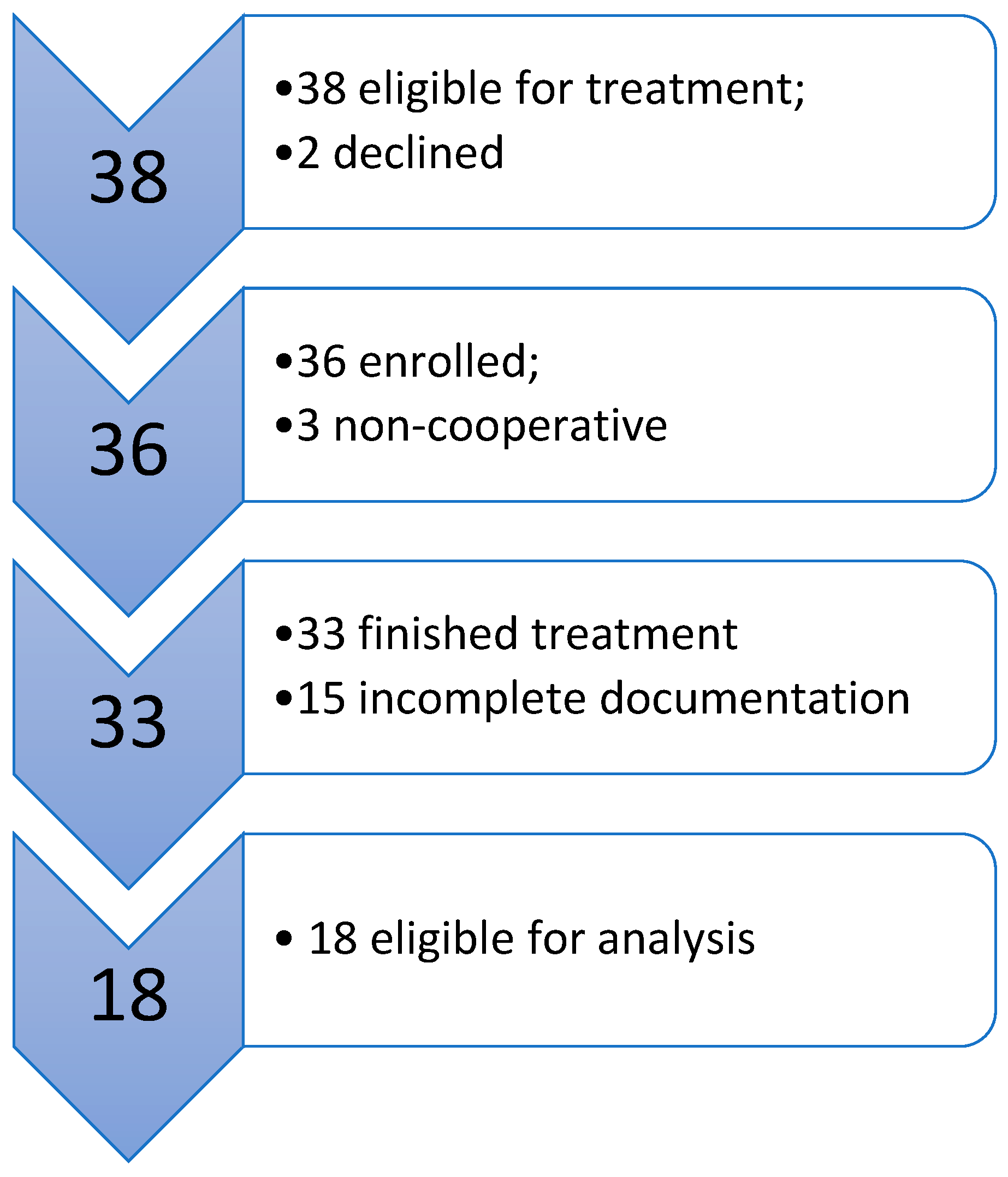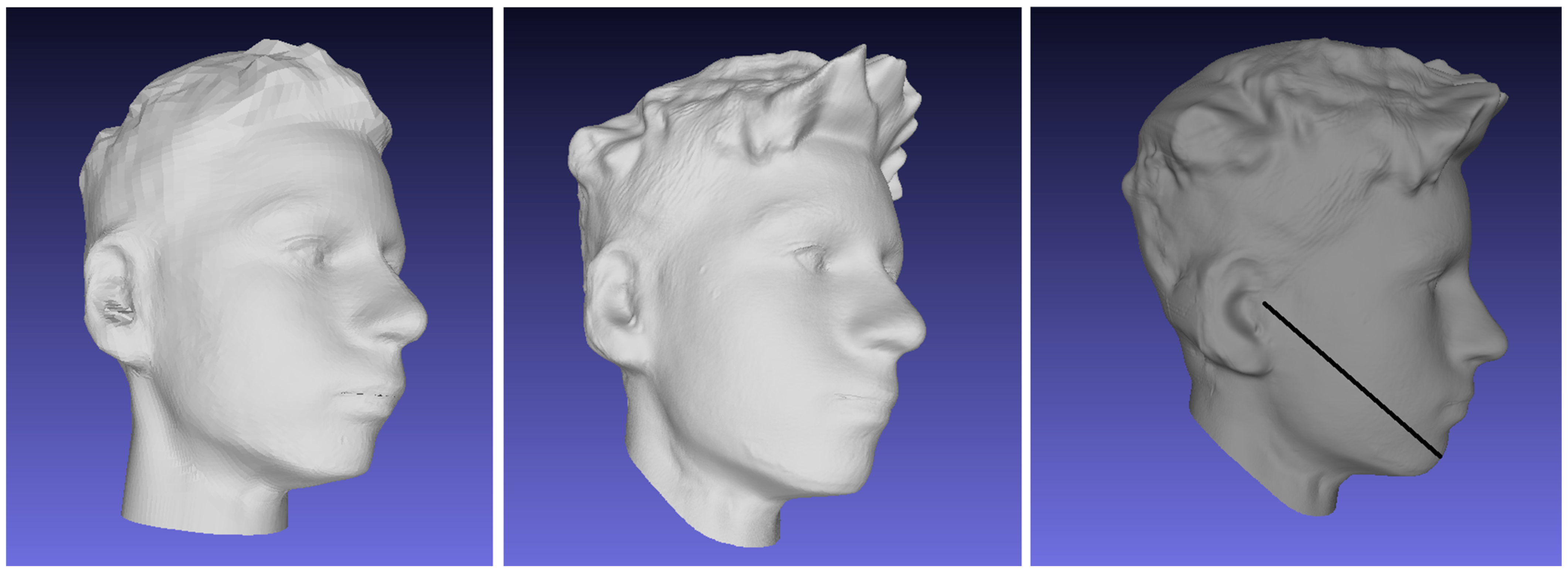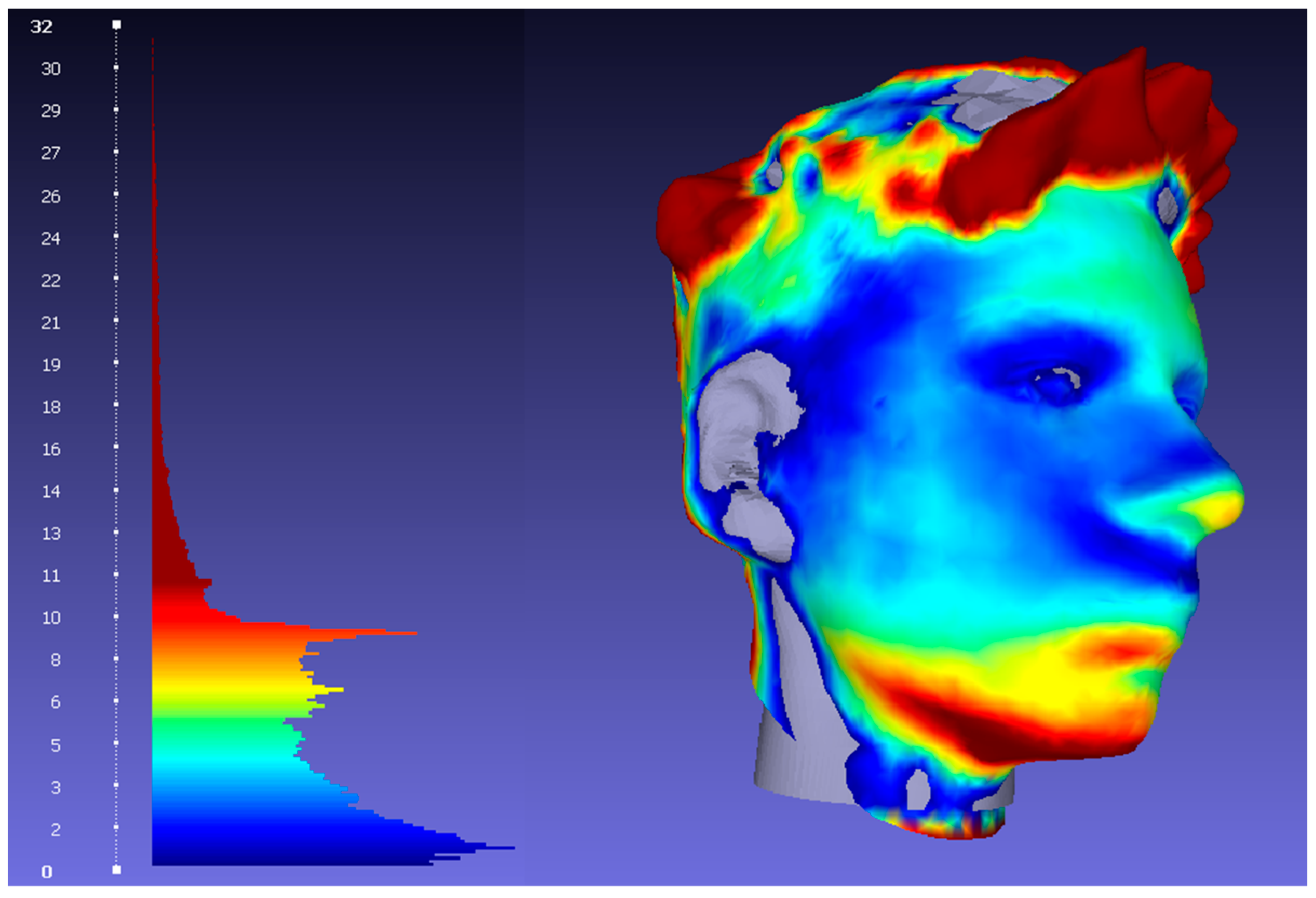Effect of the Functional Appliances on Skeletal, Dentoalveolar, and Facial Soft Tissue Characteristics
Abstract
1. Introduction
2. Materials and Methods
2.1. Lateral Cephalogram Analysis
2.2. Three-Dimensional Facial Scans Analysis
3. Results
3.1. Cephalometric Analysis
3.2. Soft Tissue Analysis
4. Discussion
5. Conclusions
Author Contributions
Funding
Institutional Review Board Statement
Informed Consent Statement
Data Availability Statement
Conflicts of Interest
References
- Guo, R.; Tian, Y.; Li, X.; Li, W.; He, D.; Sun, Y. Facial profile evaluation and prediction of skeletal class II patients during camouflage extraction treatment: A pilot study. Head Face Med. 2023, 19, 51. [Google Scholar] [CrossRef]
- Lone, I.M.; Zohud, O.; Midlej, K.; Proff, P.; Watted, N.; Iraqi, F.A. Skeletal Class II Malocclusion: From Clinical Treatment Strategies to the Roadmap in Identifying the Genetic Bases of Development in Humans with the Support of the Collaborative Cross Mouse Population. J. Clin. Med. 2023, 12, 5148. [Google Scholar] [CrossRef]
- Bittencourt Neto, A.C.; Saga, A.Y.; Pacheco, A.A.R.; Tanaka, O. Therapeutic approach to Class II, Division 1 malocclusion with maxillary functional orthopedics. Dental Press. J. Orthod. 2015, 20, 99–125. [Google Scholar] [CrossRef]
- Santana, L.G.; Avelar, K.; Flores-Mir, C.; Marques, L.S. Incremental or maximal mandibular advancement in the treatment of class II malocclusion through functional appliances: A systematic review with meta-analysis. Orthod. Craniofac. Res. 2020, 23, 371–384. [Google Scholar] [CrossRef]
- Ivorra-Carbonell, L.; Montiel-Company, J.M.; Almerich-Silla, J.M.; Paredes-Gallardo, V.; Bellot-Arcís, C. Impact of functional mandibular advancement appliances on the temporomandibular joint—A systematic review. Med. Oral. Patol. Oral. Cir. Bucal. 2016, 21, e565–e572. [Google Scholar] [CrossRef]
- Ghorbani, M.; Mousavi, S.A.; Bardideh, E.; Saeedi, P.; Shahnaseri, S.; Shafaee, H.; Akyalcin, S. The Effectiveness of Functional Clear Aligners for Class II Correction in Growing Patients: A Systematic Review and Meta-Analysis. Orthod. Craniofac. Res. 2025. [Google Scholar] [CrossRef]
- Souki, B.Q.; Vilefort, P.L.C.; Oliveira, D.D.; Andrade, I., Jr.; Ruellas, A.C.; Yatabe, M.S.; Nguyen, T.; Franchi, L.; McNamara, J.A., Jr.; Cevidanes, L.H.S. Three-dimensional skeletal mandibular changes associated with Herbst appliance treatment. Orthod. Craniofac. Res. 2017, 20, 111–118. [Google Scholar] [CrossRef]
- Kim, J.E.; Mah, S.J.; Kim, T.W.; Kim, S.J.; Park, K.H.; Kang, Y.G. Predictors of favorable soft tissue profile outcomes following Class II Twin-block treatment. Korean J. Orthod. 2018, 48, 11–22. [Google Scholar] [CrossRef]
- Shahamfar, M.; Atashi, M.H.A.; Azima, N. Soft tissue esthetic changes following a modified twin block appliance therapy: A prospective study. Int. J. Clin. Pediatr. Dent. 2020, 13, 255–260. [Google Scholar] [CrossRef]
- Qiang, J.; Wu, D.; Du, H.; Zhu, H.; Chen, S.; Pan, H. Review on Facial-Recognition-Based Applications in Disease Diagnosis. Bioengineering 2022, 9, 273. [Google Scholar] [CrossRef]
- Pellitteri, F.; Scisciola, F.; Cremonini, F.; Baciliero, M.; Lombardo, L. Accuracy of 3D facial scans: A comparison of three different scanning system in an in vivo study. Prog. Orthod. 2023, 24, 44. [Google Scholar] [CrossRef]
- Pellitteri, F.; Albertini, P.; Brucculeri, L.; Cremonini, F.; Guiducci, D.; Falconi, V.; Lombardo, L. Soft tissue changes during orthopedic therapy: An in vivo 3-dimensional facial scan study. Am. J. Orthod. Dentofac. Orthop. 2025, 167, 154–165. [Google Scholar] [CrossRef]
- Gašparović, B.; Morelato, L.; Lenac, K.; Mauša, G.; Zhurov, A.; Katić, V. Comparing Direct Measurements and Three-Dimensional (3D) Scans for Evaluating Facial Soft Tissue. Sensors 2023, 23, 2412. [Google Scholar] [CrossRef]
- McNamara, J.A. Neuromuscular and skeletal adaptations to altered function in the orofacial region. Am. J. Orthod. 1973, 64, 578–606. [Google Scholar] [CrossRef]
- Cozza, P.; Baccetti, T.; Franchi, L.; De Toffol, L.; McNamara, J.A. Mandibular changes produced by functional appliances in Class II malocclusion: A systematic review. Am. J. Orthod. Dentofac. Orthop. 2006, 129, 599.e1–599.e12. [Google Scholar] [CrossRef]
- Baysal, A.; Uysal, T. Dentoskeletal effects of Twin Block and Herbst appliances in patients with Class II division 1 mandibular retrognathy. Eur. J. Orthod. 2014, 36, 164–172. [Google Scholar] [CrossRef]
- Khan, M.I.; Neela, P.K.; Unnisa, N.; Jaiswal, A.K.; Ahmed, N.; Purkayastha, A. Dentoskeletal effects of Twin Block appliance in patients with Class II malocclusion. Med. Pharm. Rep. 2022, 95, 191–196. [Google Scholar] [CrossRef]
- Kaplan, V.; Ciğerim, L.; Ciğerim, S.Ç.; Bazyel, Z.D.; Dinç, G. Comparison of Various Measurement Methods in the Evaluation of Swelling After Third Molar Surgery. Van. Med. J. 2021, 28, 412–420. [Google Scholar] [CrossRef]
- Chiu, C.S.; Clark, R.K. Reproducibility of natural head position. J. Dent. 1991, 19, 130–131. [Google Scholar] [CrossRef]
- Mitchell, J.S.B.; Mount, D.M.; Papadimitriou, C.H. The Discrete Geodesic Problem. SIAM J. Comput. 1987, 16, 647–668. [Google Scholar] [CrossRef]
- Kirsanov, D. Exact Geodesic for Triangular Meshes. 2022. Available online: https://www.mathworks.com/matlabcentral/fileexchange/18168-exact-487geodesic-for-triangular-meshes (accessed on 15 April 2025).
- Besl, P.; McKay, N.D. A method for registration of 3-D shapes. IEEE Trans. Pattern Anal. Mach. Intell. 1992, 14, 239–256. [Google Scholar] [CrossRef]
- Farkas, L.G. Anthropometry of the Head and Face; Lippincott Williams & Wilkins: Philadelphia, PA, USA, 1994. [Google Scholar]
- Häner, S.T.; Kanavakis, G.; Matthey, F.; Gkantidis, N. Valid 3D surface superimposition references to assess facial changes during growth. Sci. Rep. 2021, 11, 16456. [Google Scholar] [CrossRef]
- Aspert, N.; Santa-Cruz, D.; Ebrahimi, T. MESH: Measuring errors between surfaces using the Hausdorff distance. In Proceedings of the Proceedings. IEEE International Conference on Multimedia and Expo, Lausanne, Switzerland, 26–29 August 2002; Volume 1, pp. 705–708. [Google Scholar] [CrossRef]
- Franchi, L.; Baccetti, T. Prediction of individual mandibular changes induced by functional jaw orthopedics followed by fixed appliances in Class II patients. Angle Orthod. 2006, 76, 950–954. [Google Scholar] [CrossRef]
- Jena, A.K.; Singh, S.P.; Utreja, A.K. Effectiveness of twin-block and Mandibular Protraction Appliance-IV in the improvement of pharyngeal airway passage dimensions in Class II malocclusion subjects with a retrognathic mandible. Angle Orthod. 2013, 83, 728–734. [Google Scholar] [CrossRef]
- Çoban Büyükbayraktar, Z.; Camcı, H. Dentoalveolar, skeletal, pharyngeal airway, cervical posture, hyoid bone position, and soft palate changes with Myobrace and Twin-block: A retrospective study. BMC Oral Health 2023, 23, 53. [Google Scholar] [CrossRef]
- Ghodke, S.; Utreja, A.K.; Singh, S.P.; Jena, A.K. Effects of twin-block appliance on the anatomy of pharyngeal airway passage (PAP) in class II malocclusion subjects. Prog. Orthod. 2014, 15, 68. [Google Scholar] [CrossRef]
- Varlik, S.K.; Gultan, A.; Tumer, N. Comparison of the effects of Twin Block and activator treatment on the soft tissue profile. Eur. J. Orthod. 2008, 30, 128–134. [Google Scholar] [CrossRef]
- Khoja, A.; Fida, M.; Shaikh, A. Cephalometric evaluation of the effects of the twin block appliance in subjects with class II, division 1 malocclusion amongst different cervical vertebral maturation stages. Dent. Press. J. Orthod. 2016, 21, 73–84. [Google Scholar] [CrossRef]
- Baysal, A.; Uysal, T. Soft tissue effects of twin block and herbst appliances in patients with class II division 1 mandibular retrognathy. Eur. J. Orthod. 2013, 35, 71–81. [Google Scholar] [CrossRef]
- Perinetti, G.; Sbardella, V.; Bertolami, V.; Contardo, L.; Primozic, J. Circumpubertal maxillomandibular growth in untreated subjects with skeletal Class II relationship: A controlled longitudinal study according to the third finger middle phalanx maturation. Am. J. Orthod. Dentofac. Orthop. 2022, 162, 937–946. [Google Scholar] [CrossRef]
- Flores-Mir, C.; Major, P.W. Cephalometric facial soft tissue changes with the twin block appliance in class II division 1 malocclusion patients: A systematic review. Angle Orthod. 2006, 76, 876–881. [Google Scholar]
- Lombardo, E.C.; Lione, R.; Franchi, L.; Gaffuri, F.; Maspero, C.; Cozza, P.; Pavoni, C. Dentoskeletal effects of clear aligner vs twin block-a short-term study of functional appliances. J. Orofac. Orthop. 2024, 85, 317–326. [Google Scholar] [CrossRef]






| Variables | Description |
|---|---|
| SNA | Sagittal relationship of the maxilla to the anterior cranial base |
| SNB | Sagittal relationship of the mandible to the anterior cranial base |
| ANB | Sagittal relationship of the maxilla to the mandible |
| Wits | Linear measurement of skeletal class |
| ANPG | Angle of convexity of the facial bony structures |
| SN:NL | Maxillary plane angle |
| MaxMandAngle | Intermaxillary angle |
| N-S-Ar | Cranial base angle |
| SArGo | Articular angle |
| MeGoAr | Mandibular angle |
| NSGn | Y-axis angle |
| SN:GoGn | Mandibular plane angle |
| CoGoMe | Condylar angle |
| U1:Max | Proclination of the upper incisors to the maxillary base |
| L1:Mand | Proclination of the lower incisors to the mandibular base |
| U1:L1 | Interincisal angle |
| U1MxPlane | Protrusion of the upper incisors to the apical base of the maxilla |
| L1MdPlane | Protrusion of the lower incisors to the apical base of the mandible |
| OJ | Overjet |
| OB | Overbite |
| Ls:E1 | Distance of the upper lip from the Ricketts’ esthetic line (Prn-Pgn) |
| Li:E1 | Distance of the lower lip from the Ricketts’ esthetic line (Prn-Pgn) |
| CoGn | Mandibular length |
| T0 | T1 | |||
|---|---|---|---|---|
| M | SD | M | SD | |
| SNA (°) | 82.17 | 4.30 | 81.99 | 4.30 |
| SNB (°) | 76.97 | 3.54 | 78.19 | 3.97 |
| ANB (°) | 5.21 | 2.11 | 3.81 | 1.67 |
| Wits (mm) | 3.28 | 3.19 | 0.79 | 2.49 |
| ANPG (°) | 8.35 | 5.65 | 5.35 | 4.80 |
| SN:NL (°) | 8.43 | 3.10 | 8.12 | 3.16 |
| MaxMandAngle (°) | 20.77 | 5.93 | 19.98 | 6.53 |
| NSAr (°) | 124.33 | 4.07 | 124.30 | 4.53 |
| SArGo (°) | 142.66 | 5.97 | 142.52 | 6.08 |
| MeGoAr (°) | 122.18 | 7.20 | 121.28 | 5.59 |
| NSGn (°) | 65.68 | 4.89 | 65.62 | 5.12 |
| SN:GoGn (°) | 26.77 | 7.30 | 26.00 | 6.86 |
| CoGoMe (°) | 119.57 | 6.92 | 119.79 | 6.27 |
| U1:Max (°) | 113.77 | 8.90 | 111.33 | 4.44 |
| L1:Mand (°) | 97.18 | 7.03 | 99.65 | 5.81 |
| U1:L1 (°) | 128.29 | 10.38 | 129.05 | 5.79 |
| U1MxPlane (mm) | 6.23 | 2.83 | 5.28 | 1.81 |
| L1MdPlane (mm) | 4.39 | 1.93 | 5.16 | 2.10 |
| OJ (mm) | 3.87 | 3.49 | 3.57 | 2.84 |
| OB (mm) | 7.58 | 3.79 | 3.32 | 2.80 |
| Ls:E line (mm) | 1.67 | 1.37 | 2.90 | 2.00 |
| Li:E line (mm) | 2.09 | 1.80 | 2.63 | 1.84 |
| CoGn (mm) | 104.70 | 4.58 | 109.94 | 5.06 |
| Paired Differences | t | df | Sig. (2-Tailed) | ||
|---|---|---|---|---|---|
| Mean | Std. Deviation | ||||
| OB (mm) | −4.262091 | 4.688027 | −3.857 | 17 | 0.001 |
| OJ (mm) | −0.306536 | 5.041305 | −0.258 | 17 | 0.800 |
| L1MdPlane (mm) | 0.767339 | 0.554796 | 5.868 | 17 | 0.000 |
| U1:L1 (°) | 0.762089 | 7.245753 | 0.446 | 17 | 0.661 |
| L1:Mand (°) | 2.467454 | 4.131599 | 2.534 | 17 | 0.021 |
| U1:Max (°) | −2.440742 | 6.227762 | −1.663 | 17 | 0.115 |
| CoGoMe (°) | 0.226650 | 5.434927 | 0.177 | 17 | 0.862 |
| SN:GoGn (°) | −0.763375 | 2.922641 | −1.108 | 17 | 0.283 |
| NSGn (°) | −0.054693 | 1.372553 | −0.169 | 17 | 0.868 |
| MeGoAr (°) | −0.892903 | 5.603276 | −0.676 | 17 | 0.508 |
| SArGo (°) | −0.168177 | 3.400253 | −0.210 | 17 | 0.836 |
| NSAr (°) | −0.030532 | 2.387120 | −0.054 | 17 | 0.957 |
| SN:NL (°) | −0.302803 | 2.333445 | −0.551 | 17 | 0.589 |
| ANPG (°) | −2.994033 | 3.262767 | −3.893 | 17 | 0.001 |
| Wits (mm) | −2.488579 | 2.678087 | −3.942 | 17 | 0.001 |
| ANB (°) | −1.402067 | 1.684264 | −3.532 | 17 | 0.003 |
| SNB (°) | 1.223792 | 1.599729 | 3.246 | 17 | 0.005 |
| SNA (°) | −0.178272 | 1.153377 | −0.656 | 17 | 0.521 |
| Li:E line (mm) | 0.540846 | 2.082717 | 1.102 | 17 | 0.286 |
| Ls:E line (mm) | 1.223523 | 2.332183 | 2.226 | 17 | 0.040 |
| CoGn (mm) | 5.24056 | 3.45793 | 6.430 | 17 | 0.001 |
| Related-Samples Wilcoxon Signed Rank Test Summary | |
|---|---|
| Total N | 18 |
| Test Statistic | 33.000 |
| Standard Error | 22.962 |
| Standardized Test Statistic | −2.286 |
| Asymptotic Sig. (2-sided test) | 0.022 |
| Sample | Tragus–Pogonion (mm) T0 | Tragus–Pogonion (mm) T1 |
|---|---|---|
| 1 | 145.05 | 151.70 |
| 2 | 144.23 | 147.67 |
| 3 | 146.54 | 149.04 |
| 4 | 148.99 | 158.62 |
| 5 | 151.77 | 154.38 |
| 6 | 156.46 | 159.83 |
| 7 | 148.40 | 151.74 |
| 8 | 147.28 | 149.53 |
| 9 | 145.29 | 148.67 |
| 10 | 151.80 | 153.94 |
| 11 | 149.02 | 158.71 |
| 12 | 150.79 | 152.76 |
| 13 | 154.15 | 156.97 |
| 14 | 137.61 | 148.88 |
| 15 | 150.27 | 152.18 |
| 16 | 157.93 | 162.24 |
| 17 | 150.78 | 153.09 |
| 18 | 140.39 | 147.90 |
| Sample | Min (mm) | Max (mm) |
|---|---|---|
| 1 | 0.000325 | 21.22 |
| 2 | 0.000562 | 19.89 |
| 3 | 0.000187 | 20.47 |
| 4 | 0 | 18.12 |
| 5 | 0.000969 | 22.65 |
| 6 | 0 | 23.41 |
| 7 | 0 | 37.59 |
| 8 | 0.000454 | 6.96 |
| 9 | 0.000112 | 8.39 |
| 10 | 0.000888 | 12.45 |
| 11 | 0.000574 | 26.74 |
| 12 | 0 | 9.45 |
| 13 | 0.000483 | 16.96 |
| 14 | 0.000288 | 12.41 |
| 15 | 0.000729 | 16.58 |
| 16 | 0 | 34.12 |
| 17 | 0 | 17.68 |
| 18 | 0.000342 | 14.29 |
Disclaimer/Publisher’s Note: The statements, opinions and data contained in all publications are solely those of the individual author(s) and contributor(s) and not of MDPI and/or the editor(s). MDPI and/or the editor(s) disclaim responsibility for any injury to people or property resulting from any ideas, methods, instructions or products referred to in the content. |
© 2025 by the authors. Licensee MDPI, Basel, Switzerland. This article is an open access article distributed under the terms and conditions of the Creative Commons Attribution (CC BY) license (https://creativecommons.org/licenses/by/4.0/).
Share and Cite
Šimac Pavičić, D.; Svirčić, A.; Gašparović, B.; Šimunović, L.; Crnković, S.; Katić, V. Effect of the Functional Appliances on Skeletal, Dentoalveolar, and Facial Soft Tissue Characteristics. Appl. Sci. 2025, 15, 7529. https://doi.org/10.3390/app15137529
Šimac Pavičić D, Svirčić A, Gašparović B, Šimunović L, Crnković S, Katić V. Effect of the Functional Appliances on Skeletal, Dentoalveolar, and Facial Soft Tissue Characteristics. Applied Sciences. 2025; 15(13):7529. https://doi.org/10.3390/app15137529
Chicago/Turabian StyleŠimac Pavičić, Doris, Anđelo Svirčić, Boris Gašparović, Luka Šimunović, Sara Crnković, and Višnja Katić. 2025. "Effect of the Functional Appliances on Skeletal, Dentoalveolar, and Facial Soft Tissue Characteristics" Applied Sciences 15, no. 13: 7529. https://doi.org/10.3390/app15137529
APA StyleŠimac Pavičić, D., Svirčić, A., Gašparović, B., Šimunović, L., Crnković, S., & Katić, V. (2025). Effect of the Functional Appliances on Skeletal, Dentoalveolar, and Facial Soft Tissue Characteristics. Applied Sciences, 15(13), 7529. https://doi.org/10.3390/app15137529






